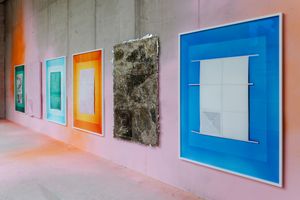Marleen Sleeuwits - Ongoing Series of False Ceilings
–A collaboration between Atelier Rijksbouwmeester and Nest in the Palace of Justice
Note: this exhibition does not take place at Nest, but at the Palace of Justice in The Hague. It is visible from outside the Palace.
- Daphne Verberg
In what kind of environment and setting does our life take place and how do we relate to it? Suspended ceilings, air grilles, carpet tiles - materials we see every day but rarely really notice. They largely determine how we experience spaces where we spend a lot of time, such as offices, schools and shops. Uniform, anonymous, and temporary.
In her latest series, Marleen Sleeuwits focuses on the suspended ceiling in particular. She is fascinated by the material, as it is widely used and has a major impact on the perception of everyday places. It is extremely cheap, but sometimes textured to resemble expensive natural products such as marble.
Besides photographs, she used moulds and casts to make reproductions of suspended ceilings. For her, these techniques have obvious similarities with photography - both create a reproduction of a surface, which can be reproduced infinitely. The result is a play between original and copy, between tangibility and illusion. What is ‘real’ if the material itself is already an imitation?
With this presentation, Marleen Sleeuwits asks questions about the lifespan of these temporary materials. Where do they end up after they are discarded? She also questions the influence of these materials on how we behave and what we experience. The uniform and anonymous character is like a façade, a backdrop. How do we relate to the artificial and reproducible in our environment?
Marleen Sleeuwits is the third in a series of eight artists with a solo presentation at the Palace of Justice, and is curated by Daphne Verberg. The exhibitions stem from a collaboration between Atelier Rijksbouwmeester and Nest. You can read more about this project here.
- Joris van den Einden


